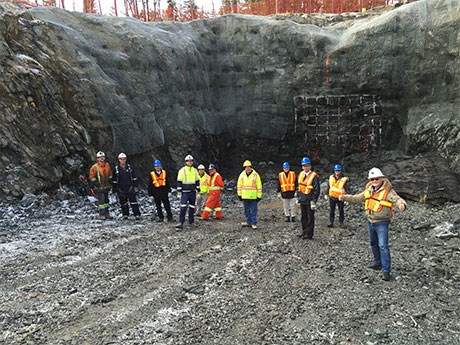Last October, Harte Gold Corp. began a transition from junior exploration company to gold producer. But Harte’s yellow brick road has had its share of lions, tigers and bears.
Seven years ago, Harte Gold was on the verge of being de-listed when shareholders asked Stephen G. Roman to take over management of the company. Yes, that Stephen G. Roman, son of Denison Mines mogul Stephen B. Roman. But more importantly at that point, the same Stephen G. Roman who was able to turn Gold Eagle Mines’ Bruce Channel deposit in Red Lake, Ontario from a prospect to a $1.5 billion asset sold to Goldcorp in 2008.
Roman stepped into a company with no other management or board and brought in fresh blood.
Among other things, the new team cleaned up the financials and negotiated with Corona Gold Corp. for its 51 per cent stake in the Sugar Zone Deposit east of the Hemlo gold fields near White River, Ontario, giving Harte full ownership.
The hard work is starting to pay off. The company began blasting a ramp down to the deposit at Sugar Zone in October, and in November it hired Roger Emdin, an engineer with experience in health and safety, permitting, and government relations to help with the transition.
The mine is now in Phase I of production, bringing up 70,000 tonnes of ore which Roman expects will yield 25,000 ounces of gold.
The property has a NI 43-101 indicated resource of 1,117,000 tonnes of ore grading 8.41 g/t for 302,000 oz., and an inferred resource of 417,000 tonnes grading 7.13 g/t for 95,000 oz. of gold.
Roman said in December that he hopes to move from Phase I to full-fledged commercial production in 12-18 months.
“We’d like to go in a smooth flow from the completion of the bulk sample right into commercial production,” Roman said. “We think that the permitting should be completed in that same time.”
Harte should also have its own mill in place at that time or soon after, depending on permits and financing. Currently, the ore is transported 60 kilometres east to Barrick Gold’s mill in Hemlo.
Technica Mining of Sudbury is mining the bulk sample for a fixed price contract of $20 million, $5 million of which will be paid in Harte Gold common shares.
“Our ore is very amenable to simple gravity recovery, so we don’t need a cyanide mill,” Roman said, adding that this system would recover 85-90 per cent of the gold. “It’s an easy mill to permit. You can find module mills these days that are much, much cheaper than they were a number of years ago.”
A positive preliminary economic assessment dated July 2012 proposed a 750 t/d underground mine with ramp access. It estimated a capex of $108 million, all-in production costs of $600 per ounce and a six-year mine life.
Although geologically the site is similar to Hemlo (which is serviced by Marathon in northwestern Ontario), geographically and socio-economically the Sugar Zone is a separate area in northeastern Ontario just off the Trans-Canada Highway between White River and Hornpayne near the Pic Mobert First Nation.
“Pic Mobert are friends and they’re supporters. We’ve had a very good relationship with them. They’re very supportive of moving the project ahead,” said Roman.
Despite the seemingly rosy picture, the markets remained underwhelmed. One month after the company’s announcement that blasting had commenced, the stock was still trading at $0.075, giving it a market cap below the value of the projected gold production from its bulk sampling alone.
“I think our market cap is very low compared to our peers that are near us like Wesdome and Richmont, but of course they are pouring gold. My expectation is that when we are actually shipping ore to the mill and generating revenue, we should have a re-rating in the market,” Roman said.
Last fall was a full circle moment for Roman as well. In December, the Prospectors and Developers Association of Canada (PDAC) announced that he along with Robert Cudney and John Witton would be awarded the Bill Dennis Award for the Bruce Channel gold discovery.
“I’m quite excited,” Roman said.
It’s continued validation of his leadership in the field – literally, a life-long venture considering he started going into the mines at age five.
“My father obviously was a big influence on me, and the company that he built was a fantastic company,” Roman said. “I gravitated to the exploration side of things.”
“It’s what I know, it’s what I love.”
Although Roman has lived in southern Ontario most of his life, he has always had a personal connection with Northern Ontario.
“>It’s like my second home. The whole expanse of the north is very appealing to me.”



.jpg;w=120;h=80;mode=crop)